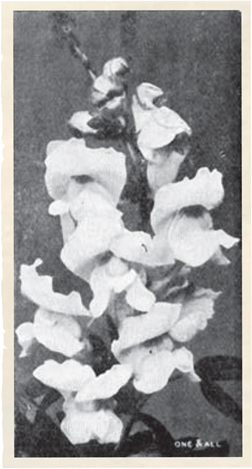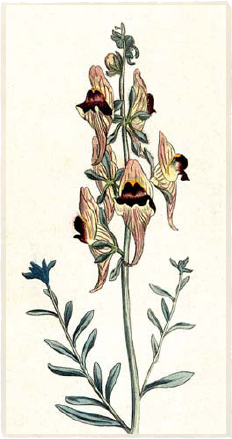 Antirrhinums
Antirrhinums 
 Antirrhinums
Antirrhinums 
 The Plants in Beds
The Plants in Beds 
AS a bedding plant to provide a display of flowers during late summer and early autumn the Phlox is surpassed by few. Before we proceed, further attention must be drawn to the three distinct types of the plant, viz., tall, medium, and dwarf. The first-named grows from 2 feet 6 inches to 3 feet high in well-cultivated soil, the dwarf 1 foot, and the medium about half way between the two, a varied assortment of colours being found in each type, and to which attention will be drawn later. The tall varieties will need staking and tying.

Generally speaking, the medium and dwarf types are best for beds, although, where very large, isolated beds are to be filled, and a bold display is desired, the tall, medium, and dwarf varieties may all be employed. It is preferable to fill a bed with Antirrhinums alone; combined with other plants, half their beauty is lost. Naturally the colours employed will depend upon individual taste, but I would warn anyone against employing an indiscriminate mixture of colours in one bed. Where a bold display is to be made, I am in favour of using one colour, or shades of a colour, only in a bed, and in such a case, of course, any of the colours available may be chosen. A good and striking mixture is deep rich crimson and white. Thus the centre of the bed might be filled with a crimson variety belonging to the medium type, and this surrounded with a broad band of a dwarf white sort. The beautiful terracotta and delicate pink shades go well together, but other colours ought not to be mixed with them. Yellow is a difficult colour to use in beds, and should either be kept by itself or used in conjunction with white.
 Antirrhinums as Border Plants
Antirrhinums as Border Plants 

Antirrhinum triste, Melancholy or Black-Flowered Toad-flax
For filling up blank spaces in the mixed or herbaceous border, the various types of the Antirrhinum are of considerable value. Generally speaking the medium and tall forms are best for this purpose, but where gaps occur near the front of the border, the dwarf varieties may sometimes be used to advantage. Where groups of such bulbs as Daffodils and Tulips are grown in the border, the Antirrhinums may be planted between them, so that by the time the foliage of the bulbs is dead, the Snapdragons will have formed sturdy plants, and have filled what would otherwise have been a blank space.
When planting in borders it is advisable to allow a little more space, say 3 inches for each type, between the plants than advised for beds, as it is not so essential or desirable that the plants shall form a close mass of foliage and flowers. The same attention to the arrangement of the various colours must be given, and it will also be necessary to bear in mind the colours of the flowers of other plants close by that are likely to be open at the same time.
 Antirrhinums in Window-boxes and Tubs
Antirrhinums in Window-boxes and Tubs 
Even those who do not possess beds and borders in which to grow the Snapdragons need not despair, as they can be successfully grown in window-boxes and tubs, even in large towns, and possess the advantage of thriving in soil that would be too poor for the welfare of many other plants. The boxes or tubs should be well drained by placing some pieces of broken pots, bricks, or, failing these, rough stones or even cinders over the holes in the bottom, then put some rough soil over these, and subsequently fill up with the best soil obtainable. For preference it should consist of good loam two parts, and coarse sand and old mortar half a part each. Whatever soil is used the incorporation of some old mortar will benefit the plants. Usually the dwarf or medium varieties are best for the purposes named, and it is advisable to keep one colour, or shades of a colour, together.
 Antirrhinums in Walls
Antirrhinums in Walls 
Where an old stone or brick wall is available this will form an ideal situation for growing the Snapdragon in a natural and semi-wild manner, and once the plants are established, they may usually be relied upon to reproduce themselves year after year. The medium and dwarf varieties are best for the purpose, and a good mixture will generally give the most pleasure, although, of course, individual taste must be considered. In any case do not choose named varieties, as these are generally highly bred, and do not possess the same vigour as ordinary seedlings.
The best means of establishing these plants on old walls is undoubtedly by seeds, and these should be sown in August or September. The joints between the stones or bricks may have a little of the mortar dug out with a cold chisel or an old knife, and, although the plants can be made to grow in the side of the wall near the top, they usually do better on the top itself. Holes two inches deep will suffice, and into these some good ordinary potting soil should be rammed rather firmly. After this is done a few seeds may be sown in each hole, pressed well into the soil, and then left to take their chance. The colours of the flowers of plants growing in walls always appear to me to be richer than those of similar varieties growing in cultivated soil.